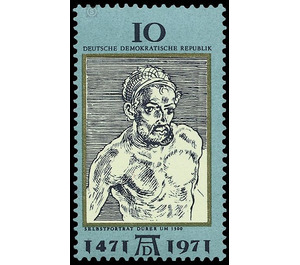500th birthday of Albrecht Dürer - Germany / German Democratic Republic 1971 - 10 Pfennig
Theme: Calender
| Country | Germany / German Democratic Republic |
| Issue Date | 1971 |
| Face Value | 10.00 |
| Color | black green |
| Perforation | K 12 1/2: 13 |
| Printing Type | offset |
| Stamp Type | Postage stamp |
| Item Type | Stamp |
| Chronological Issue Number | 1414 |
| Chronological Chapter | GER-DDR |
| SID | 791019 |
| In 36 Wishlists | |
500th Anniversary of Albrecht Dürer On the occasion of the 500th birthday of Albrecht Dürer, the Ministry of Posts and Telecommunications of the German Democratic Republic issues three multicolored special postage stamps. Albrecht Dürer On the occasion of his 500th birthday on May 21, 1971, the German Democratic Republic honors the great painter, graphic artist and art theorist Albrecht Dürer. It continues a tradition that goes back to the dawn of the working-class movement and is supported by the idea that everything that has been valuable and forward-looking in the history of human society has entered the culture of the working class and victorious socialism as a permanent legacy is recorded. Dürer's rich work is marked by the great class struggles of the early bourgeois revolution, which culminated in Germany in the Peasants' War and the Reformation. Allied with the progressive forces of his time, he gave an artistic synthesis in a unique synthesis of the whole variety of her worldview and in his realistic art formulated an ideal of the creatively acting human being who determines his fate. This image of humanity, which only begins to be fully fulfilled in socialism, the deep humanistic content and the beauty of its works are the reasons for the current significance of the great Renaissance master in the present. There are no more self-portraits of any artist of the Renaissance than Albrecht Dürer. Even as a thirteen-year-old he drew his picture in the mirror. The art collections in Weimar have a drawing - on the 10 Pfennig value it is reproduced in the excerpt, - on which Dürer has presented as an act. In order to be able to correctly assess the significance of this work in terms of art history, it must be remembered that in the art of the Middle Ages, which is oriented towards the Christian hereafter, self-portrait did not appear at all, and the representation of the naked man only in connection with biblical material. It was not until the Renaissance that the social preconditions arose. In his drawing, Dürer goes even further than his contemporaries when he unites both themes in one sheet in a way that is bold even for the early sixteenth century.


